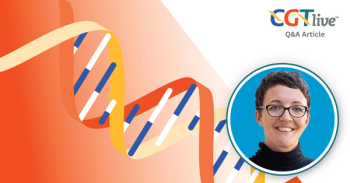
The Importance of Single Cell Analysis to the Field of Cell and Gene Therapy
Brian Kim, MBA, the chief executive officer of Mission Bio, discussed the company’s Tapestri platform for single cell sequencing.
Traditional bulk measure DNA sequencing allows for the detection of mutations and other genetic changes in a sample of cells, but it does not indicate whether the changes are occurring within single cells or across multiple cells in the sample. Singe cell analysis, on the other hand, provides information on genetic changes at the single cell level, which carries important implications for the safety and efficacy of cell and gene therapy products.
Mission Bio's Tapestri platform is intended to enable cost effective and time-efficient single cell sequencing. At
CGTLive: Can you give some background about Mission Bio and what the company presented at ASGCT this year?
Brian Kim, MBA: Mission Bio is a company that has a unique single cell technology. It has the ability to look at both DNA and proteins and to some degree RNA and we can analyze it on the backend with next generation sequencing platforms such as Illumina (that's our detection platform). This capability allows us to see things that are happening at the single cell level, where with traditional bulk measure sequencing you can't see certain things. So for instance (this is just as an example): Cancer is a disease of the cooccurrence of certain mutations. If you're doing a bulk measure of next gen sequencing, and you're looking at the amount of mutations, you may see a lot of mutations after you've sequenced all your cells, but you can't find out if those mutations came from one cell, or from multiple different cells.
With our technology, because it allows you to sequence each individual cell, you can find out if a single cell has a cooccurrence of mutations or it doesn't. As a result, it's a really powerful tool for cancer biomarker discovery and it has the same kind of relevance for cell and gene therapy assays, as well, where you're looking for those cooccurrence of events in a single cell.
The big theme as we come into ASGCT this year is really the launch of new products that we have that allow us to be able to characterize what's happening in gene edited cells.
Is there anything specific the company is working on that you think doctors and the broader healthcare community would be interested to know more about?
I think what physicians and caretakers will ultimately care about is whether or not the gene editing drugs that go into patients will be both safe and efficacious... Our platform allows us to be able to characterize those important measures around safety and potency for our drugs. The platform that we have is called Tapestri and we're developing a suite of assays that you can all run together—things like translocations, off- and on-target—and there's a variety of other attributes you're looking for. Currently, the way you have to measure these are through individual tests and individual platforms—so you may have to do 3 or 4 tests to make sure that the gene edited product is going to be safe and efficacious for patients.
For us, our value proposition is that we can put all of those assays together in 1. It saves a tremendous amount of time and it really reduces the cost and allows manufacturers of these drugs to be able to do it much faster and get products out to customers—and to be able to see the data in a way together that really reinforces the safety: It shows how safe the product is going to be.
So we're pretty excited about the value proposition. We had one assay that we just launched here at ASGCT, called Translocation, and we'll have a few more. I think once we launch all of these assays, and it comes together, as I said, just as one assay—I think customers will see how powerful it is—and ultimately, the physicians and caretakers will want to see this kind of test brought forth to all the therapies that ultimately patients will undergo.
Are there any future plans for the company you would like to discuss?
We're pretty excited about our position in the marketplace and the new products that are gonna be coming out. We had a great presentation just yesterday by Samantha Maragh, PhD, of the National Institute of Standards & Technology (NIST). She was really kind of showing the importance of really having good standards and controls to really understand what kind of edits are being made and are those edits on target? Are they safe? Are they efficacious?
Clearly where she was going was that single cell analysis is a very, very effective way to do this and she put some great comparison charts up there. I would just encourage everyone to kind of go look at her presentation. If you look at that it kind of reveals to some degree the roadmap of additional products that we're going to launch. The products that we have right now are just the starting point. As we look into 2025, we have a lot of other products that we're going to launch.
In addition, we want to make our Tapestri platform which commercially launched in 2017—we really want to bring down the cost per sample. That's going to be something that's gonna be very important for us. Right now, we just launched a new product that can bring it down by a factor of 3. I think we have technologies that can bring it down to a factor of 6. My goal is to bring it down by a factor of 10. The reason why is we want our product to be more widely adopted by industry and the way you do that is to make it more cost-effective.
So not only new assays, but making the platform more cost effective, so that more manufacturers and more scientists will be using this, is really important I think to the long-term growth and safety of cell and gene therapy products.
Is there anything else you would like to share?
We're really excited about what we're here doing at Mission Bio. I would say that the single cell market has really been around for 10 years and the first 10 years has really been marked by a lot of discovery. I think what we're gonna see over the next 10 years is the adoption and the application of these technologies, really in applied and clinical settings, and particularly in cell and gene therapy areas.
As such, we're really excited about how well Mission Bio is positioned, the customer reception to our technology, and really seeing how much of an impact it can make. So I would just ask our customers out there, physicians, and everyone else to really pay attention to Mission Bio because I think we're going places.
This transcript has been edited for clarity.
Newsletter
Stay at the forefront of cutting-edge science with CGT—your direct line to expert insights, breakthrough data, and real-time coverage of the latest advancements in cell and gene therapy.































